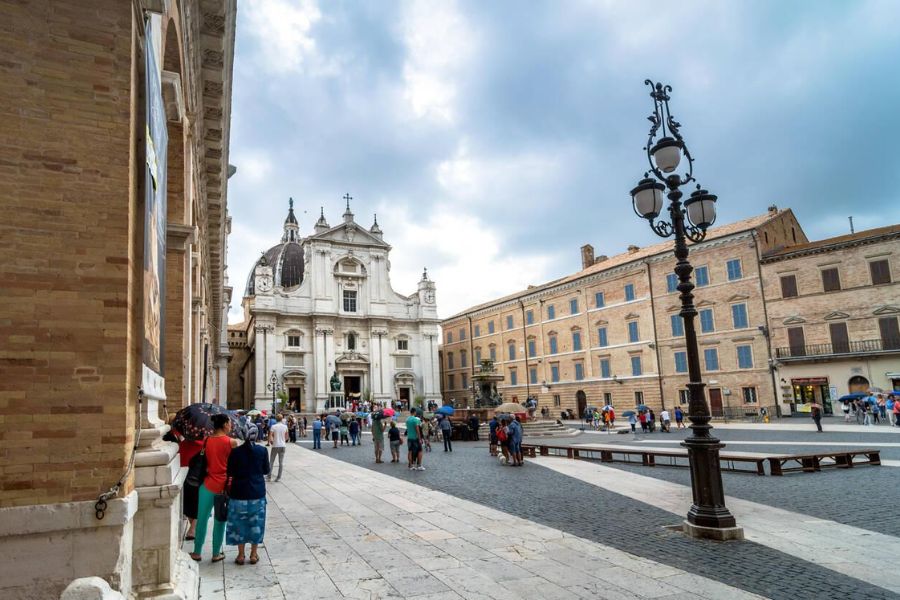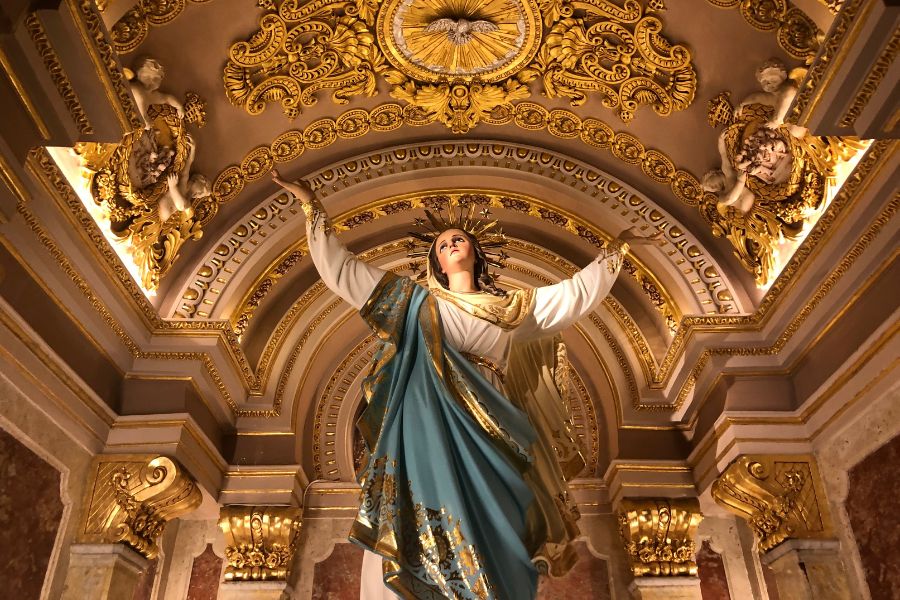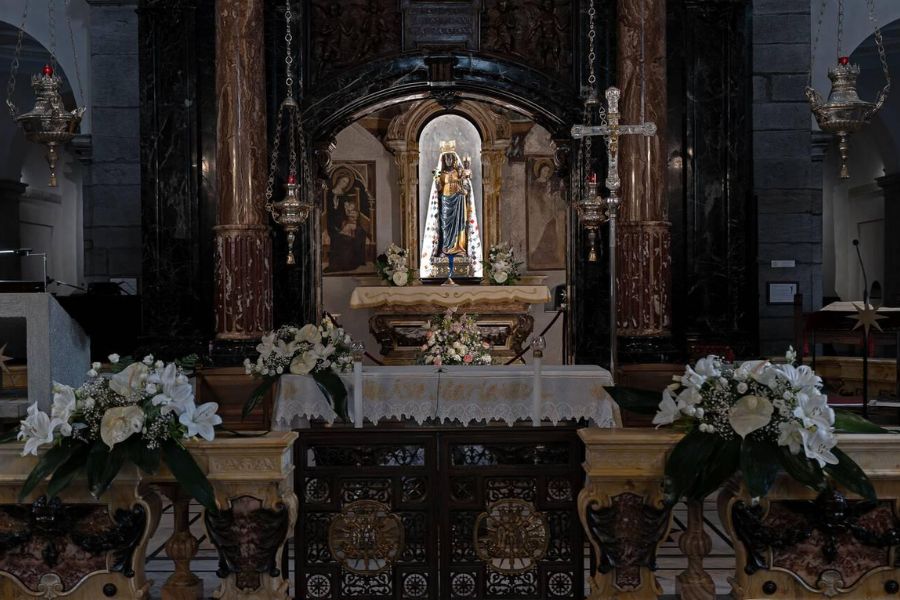When I first stepped into the Holy House of Loreto, I felt an immediate connection to centuries of faith and history. This small brick structure in Italy’s Marche region isn’t just a building—it’s believed to be the actual home where Mary was born and where the Annunciation took place.
The Holy House of Loreto stands as one of Christianity’s most powerful examples of sacred architecture, where physical space transforms into spiritual experience for countless pilgrims.
Walking through this humble sanctuary, I was struck by how ordinary materials—simple bricks and mortar—could create such an extraordinary spiritual impact. The walls that millions have touched in reverence over centuries seem to hold prayers within them.
Unlike grand cathedrals that inspire through magnificence, Loreto’s power comes from its intimacy and connection to everyday life.
The architectural simplicity of the Holy House serves a deeper purpose than mere shelter. Inside this space, where heaven supposedly met earth in the miracle of the Annunciation, pilgrims find a direct link to sacred history.

I’ve visited many religious sites, but few match Loreto’s ability to make the divine feel accessible through architecture that speaks not of power but of humble holiness.
The Lore of Loreto: Unveiling the Holy House
The Holy House of Loreto stands as one of Christianity’s most remarkable treasures, drawing pilgrims for over seven centuries. This humble structure is believed to be the very home where Mary received the Annunciation and where Jesus spent his childhood years.
Legend and History
I was amazed to learn that the Holy House of Loreto is said to be the actual home of the Virgin Mary from Nazareth. According to tradition, this is where the angel Gabriel appeared to Mary and where the Word became flesh through the Incarnation.
What makes this site truly extraordinary is its remarkable preservation. The simple stone structure measures about 30 by 13 feet – modest dimensions for such profound significance.

When I visited, I noticed the walls were made of limestone and shaped like a rectangle, consistent with ancient Palestinian building techniques. Pope Benedict XV declared Our Lady of Loreto as patroness of air travelers, connecting the miraculous transport of her home to modern aviation.
The Journey from Nazareth to Italy
The most fascinating aspect of Loreto’s story is how the house allegedly arrived in Italy. According to tradition, when the last Christian strongholds in the Holy Land fell to Muslim forces in 1291, angels miraculously transported Mary’s house from Nazareth to save it from destruction.
The house reportedly made several stops. First in Tersatto (modern Croatia), then to Ancona, and finally settling in Loreto in December 1296. This extraordinary journey has made Loreto the second most important pilgrimage site after Nazareth for those seeking to connect with the Holy Family.

Historical documents show that a noble Byzantine family named Angeli may have transported the stones of the house during the Crusades. This more practical explanation suggests they rescued these sacred materials before Nazareth fell.
I found it remarkable that archaeological studies have confirmed the stones aren’t native to Italy but match those from the Nazareth region.
Architectural Divinity: Analyzing Loreto’s Sacred Structure
The Holy House of Loreto represents one of Christianity’s most fascinating architectural marvels. Its simple brick structure houses profound spiritual significance while inspiring centuries of artistic and architectural development.
Design and Symbolism
The Holy House measures roughly 30 by 13 feet—humble dimensions that belie its spiritual importance. Its simple brick walls stand without foundations, a fact that many believers point to as evidence of its miraculous origin.
Inside, I was struck by the stark contrast between the plain brick interior and the ornate marble screen that surrounds it. This screen, designed by famous Renaissance architects, transforms the simple dwelling into a sacred reliquary.
The black Madonna statue draws your eye immediately upon entering. Carved from cedar wood, this darkened figure represents Our Lady of Loreto watching over her earthly home.

What fascinated me most was how the builders incorporated the original structure within the basilica. Rather than dismantling it, they preserved the house as a holy heart within a grand body.
Influence on Renaissance Art and Beyond
Leonardo da Vinci visited Loreto and studied its proportions, leading some art historians to suggest its influence on his architectural drawings. I could see why it captivated him—the perfect harmony between simplicity and sacredness.
The Holy House inspired countless chapels across Europe and beyond. Many Catholic churches feature Loreto chapels that mimic its dimensions and atmosphere.
Artists frequently depicted the miraculous transport of the house by angels, creating a unique genre of religious art that spread Loreto’s fame throughout Christendom.
The influence extends to modern sacred architecture too. Architects still study how Loreto balances intimate sacred space within monumental structures.
When visiting, take time to notice how light enters the space at different hours. The builders cleverly positioned windows to create dramatic effects that heighten the spiritual experience.
Spiritual Significance: Inside the Marian Shrine
The Holy House of Loreto invites pilgrims into a profound spiritual experience that connects them to the essence of Mary’s life. Walking these ancient walls, I felt a tangible connection to centuries of faith and devotion.

The Virgin Mary and Her Roles
Inside the Marian Shrine at Loreto, Mary’s presence feels almost palpable. The shrine honors her unique roles in Christian tradition as both Mother of God and spiritual mother to all believers.
When I first entered the Santa Casa, I was struck by the reverence visitors showed before the Black Madonna statue. This darkened wooden figure, dressed in ornate robes, represents Mary’s protective and nurturing nature.
Pilgrims come seeking her intercession for various needs—health concerns, family troubles, or spiritual guidance. The walls that witnessed the Annunciation now witness countless prayers.
Mary’s humility and acceptance of God’s will is a central theme here. Her “yes” to becoming Christ’s mother is commemorated in this very space, making it a powerful reminder of surrender to divine purpose.
Symbols and Icons in the Santa Casa
The interior of the Holy House contains rich symbolism that deepened my appreciation of this sacred space. The most striking feature is the ancient stonework, preserved from what believers identify as Mary’s original home.
I noticed how the walls are partially covered with marble reliefs depicting scenes from Mary’s life. These artistic elements tell the story of salvation history through Marian events.
Oil lamps hang throughout, symbolizing perpetual prayer and Mary’s role as a light guiding believers to Christ. Their gentle glow creates an atmosphere of contemplation.

The ex-voto offerings—small silver hearts, photographs, and handwritten notes—moved me deeply. These tokens represent countless answered prayers and miracles attributed to Mary’s intercession at this shrine.
The Sacraments within Holy Walls
The Santa Casa isn’t just a historical relic but remains a living center of sacramental life. Daily Mass is celebrated within or near these walls, allowing pilgrims to receive Communion in this spiritually charged setting.
I watched families bringing children for Baptism, continuing a tradition spanning centuries. The connection between Mary’s motherhood and these children beginning their faith journey was beautiful.
First Communion celebrations hold special significance here. Young people receive the Eucharist where Mary herself once lived, creating a powerful connection to the faith’s roots.
The sacrament of Reconciliation is available throughout the day. Many pilgrims seek healing and forgiveness in this place associated with new beginnings and divine mercy.
Miracle and Mystery: The Phenomena Surrounding the Holy House
The Holy House of Loreto stands as one of Christianity’s most enduring mysteries, with accounts dating back to 1294 when it reportedly appeared suddenly in Italy. This sacred structure has become a center of miraculous phenomena that continue to draw pilgrims from around the world.
Accounts of Miraculous Healing
When I visited Loreto, I was amazed to learn that thousands of miracles have been recorded there throughout history. The basilica walls are lined with ex-votos—small tokens of gratitude from those who believe they were healed through Our Lady of Loreto’s intercession.

One particularly moving story I encountered was of a blind child who reportedly regained sight after praying in the Holy House. The miracle registry, kept since medieval times, documents cases of cures from paralysis, terminal illness, and other afflictions deemed medically inexplicable.
Pilgrims still come seeking healing today. I watched as visitors touched the ancient walls with reverence, many with tears streaming down their faces. The atmosphere inside is charged with a palpable sense of hope and faith.
Pope Pius IX and Recognition
Pope Pius IX had a special connection to Loreto. During my research, I discovered he visited the shrine multiple times and granted special privileges to the sanctuary in 1850.
The Pope officially recognized the authenticity of the Holy House tradition, strengthening its position within the Universal Church. He commissioned beautiful artistic works to adorn the site and established December 10th as the feast day celebrating the miraculous translation of the house.

What struck me most was his personal devotion. After surviving a near-fatal accident at the nearby monastery of Fossombrone, Pius IX attributed his survival to Our Lady of Loreto’s protection. This experience deepened his commitment to promoting this sacred site.
His papal bull strengthened Loreto’s status as one of Catholicism’s most important pilgrimage destinations, a designation that continues to this day.
Pilgrimage and Devotion: The Holy House as a Spiritual Journey
The Holy House of Loreto stands as one of Christianity’s most powerful pilgrimage destinations, drawing faithful travelers seeking both physical and spiritual transformation through their connection to Mary’s home.
Personal Experiences and Testimonials
I’ll never forget my first visit to Loreto’s Holy House. Standing within those ancient walls, I felt an overwhelming sense of peace that many pilgrims describe as life-changing.
“After Nazareth, Loreto is the ideal place to pray while meditating on the mystery of the Incarnation,” a fellow pilgrim told me, echoing Pope Paul II‘s sentiments about this sacred space.
What makes this journey special isn’t just the destination but the preparation. Many pilgrims I’ve met walk for days along ancient routes, each step becoming a prayer. Some carry specific intentions – healing, gratitude, or spiritual renewal.
The most moving testimonials often come from those who arrive with no expectations. A woman from Boston shared, “I came curious but left transformed, feeling Mary’s presence in a way I never imagined possible.”
Marian Devotion and Contemporary Practices
Devotion to Mary flourishes at Loreto through traditional and modern practices. The Annunciation is particularly celebrated here. Special Masses and prayers are held to honor when Archangel Gabriel visited Mary.
Many pilgrims participate in the Loreto Novena. This is nine days of prayer honoring the Immaculate Conception and seeking Mary’s intercession. This practice has adapted to contemporary life, with online prayer groups connecting devotees worldwide.
I’ve observed families teaching children traditional Marian prayers. They use smartphone apps to guide their pilgrimage experience. This blend of old and new keeps the devotion vibrant.
Candle lighting remains one of the most popular expressions of faith. The basilica glows with thousands of flickering lights. Each represents a pilgrim’s prayer or intention left in Mary’s care.
Digital prayer walls now complement physical ones. They allow distant devotees to participate in the spiritual community surrounding the Holy House.

